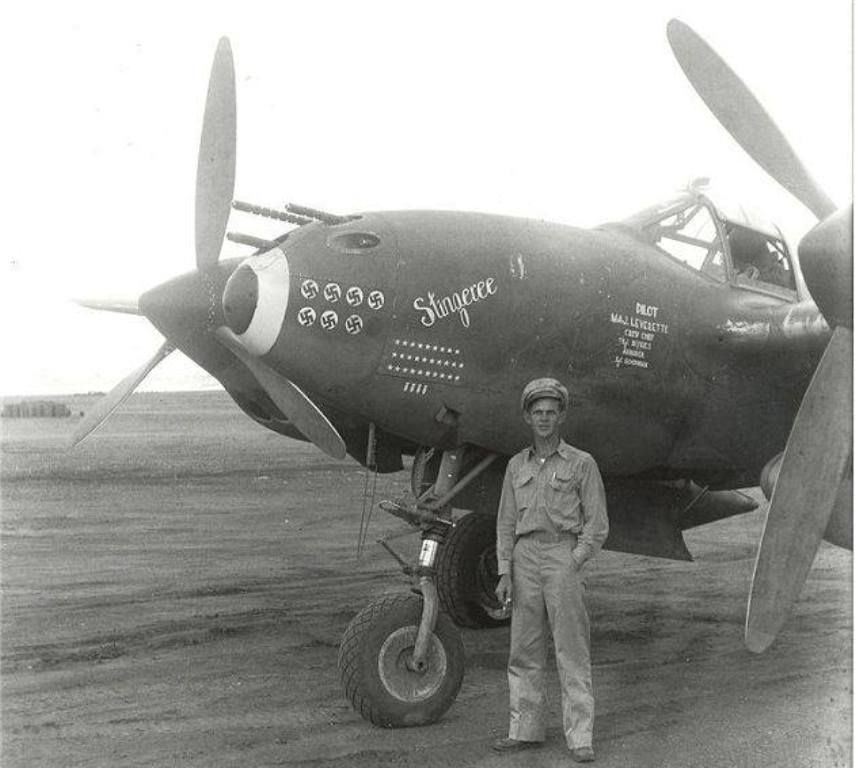
On October 9 the 14th Fighter Group’s luck was about to change. Fighter Command had assigned the group to protect a British convoy consisting of the cruiser HMS Carlisle and the destroyers Panther, Petard, Rockwood and the Greek destroyer Miaolis.
The convoy was sailing through the straights between Scarpanto and Rhodes, their ultimate destination Alexandria. That morning, Major William Leverette led two flights of P-38s to rendezvous with the conv oy at midday. Two planes developed engine problems and had to return to base, so Leverette was reduced to seven fighters. He led Red Flight’s four P-38s, while Blue Flight’s three airplanes rounded out the patrol.
It was almost noon when Leverette spotted the convoy, which was under attack at that very moment by a swarm of Stuka 87 and Stuka 88s. Before the P-38s were in firing range they could see the damage that the Stukas were inflicting on the hapless convoy. The Stukas were diving down like angry birds of prey, dropping their bombs with seeming impunity. One German bomb scored a direct hit on a destroyer, causing the British vessel to break apart and sink.
The Stuka pilots had little time to savor their triumph, because the avenging P-38s were on them a moment later. There were at least 30 Stukas and seven P-38s, but the Germans planes were no match for these forked- tailed furies. This is not to say they w ere defenseless, for they had wing cannons and a rear gunner, but by the same token, they were no Messerschmitt Bf 109s.
For the next few minutes the blue Aegean skies were filled with dozens of aircraft twisting, turning, gaining altitude then plunging downward, the pilots per forming air pirouettes in a deadly ballet of life and death. It was less a dogfight than an unequal, one-sided slaughter. The P-38s had a field day, effortlessly downing German dive bombers with short, staccato bursts from their guns. Machine gun bullets, including 50-caliber slugs, tore into Stuka fuselages, soon causing the gull-winged aircraft to burst into flames and spiral down into the dark, wine-colored sea.
When it was over, no fewer than 16 German Stukas had been destroyed, and the surviving convoy ships made it to Alexandria safely. Major Leverette downed no fewer than seven Stukas, an impressive total by any standard. But after a few days the Americans withdrew their fighters.
An American pilot was to make his own daring kill in Mediterranean skies. During 1943, from their base in Tunisia, Lockheed P-38 Lightnings of the 14th Fighter Group were tasked with offering protection to the many convoys suffering the attentions of Luftwaffe bombers. In one notable mission on 9 October 1943, three of the Group’s P-38s, led by Colonel William Leverette, attacked a formation of Junkers Ju 87s. After shooting down six of the dive-bombers, Leverette found himself on the tail of another Stuka, only to discover that his guns were now empty. With his final burst having already silenced the enemy’s rear gunner he decided that he should close with the Ju 87. As the gap between the aircraft shrank he then lined up his propeller with the Ju 87s rudder, and just as it bit into the rudder he cut his throttle and allowed the blades to slice large pieces from the unfortunate aircraft. As the Ju 87 lost control and spiralled into the sea, Leverette had accounted for his seventh victim of the day (his final score by the end of the war would eventually climb to 11).
The 37th FS arrived back at Sainte Marie du Zit on October 12 1943: without the Lightnings, British forces in the Aegean would once again be at a disadvantage when dealing with the Luftwaffe.
Bill Leverette was subsequently decorated for his achievement. Later, his CO, Oliver B `Obie’ Taylor, wrote:
“Bill’s exploits on this day established what turned out to be a theatre record, for which he received the Distinguished Service Cross. “I tried unsuccessfully to persuade XII Bomber Command that Bill should get the Medal of Honor. Of course the DSC was subject to meeting pretty stiff requirements and something of a rarity itself.”
Fifty years after the event, Bill Leverette learnt from a former squadron colleague that the 37th FS had gone into action with just 350 rounds of .50-cal ammunition per gun, as opposed to the standard 500 rounds. When enough rounds had been expended, causing ammunition to fall below a certain level, g-forces could affect the feed, resulting in a stoppage. To alleviate this, rounds were removed to enable wooden blocks to be placed at the bottom of the ammunition trays.
Bill lamented: “I was credited with seven Stukas destroyed, or 50 rounds (per gun) per kill, on average. Another 150 rounds (per gun) would have meant another three kills, at least.